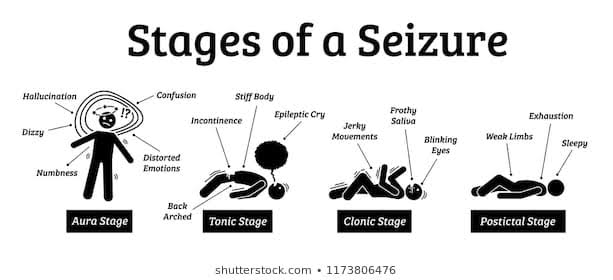Epilepsy simply means recurring seizures. It is a non communicable neurological disorder characterized by unprovoked and recurrent seizures. Seizures can be further defined as sudden uncontrolled electrical disturbances in the brain. It can manifest in different ways, such as:
- Convulsions: This is what most people think of when they hear epilepsy or seizure. It is a sudden involuntary movement of parts of the body.
- Loss of consciousness
- Sensory signs: For example, seizures can manifest as a tingling or numbness of parts of the body. It can cause changes to a person’s vision, hearing, smell or taste.
- Psychological manifestations: Seizures can cause behavioral changes or hallucinations.
Epilepsy affects over 50 million people of all ages and gender. One seizure episode alone does not indicate epilepsy. The seizure must be recurrent before a diagnosis of epilepsy can be made.
CAUSES
Epilepsy has no known cause in about 50% of cases while in the other 50%, the causes may be due to:
- Traumatic head injury
- Stroke
- Hypoxia ( lack of oxygen to the brain)
- Brain infections like meningitis and encephalitis
- Genetics ( a family history of epilepsy)
- Substance abuse e.g. Drugs and alcohol
- Brain tumour
- Infectious diseases like AIDS
- Prenatal injury to the brain
- Dementia and Alzheimer’s disease (in adults)
Types and symptoms
Epilepsy is characterized by seizures. The symptoms depend on the type of seizure. There are two basic types of seizures, namely:
- Generalized seizure: The abnormal electrical discharge occurs in both halves of the brain at the same time. It can be further divided into 6 types, each with their specific symptoms. The divisions include:
- Absence or Petit mal seizure (brief loss of awareness)
- Tonic seizures (stiffening of muscles)
- Atonic seizure (loss of muscle control)
- Clonic seizure (jerky movements)
- Myoclonic seizure (twitching of limbs)
- Tonic-clonic or grand mal seizure: It has both tonic and clonic phases. It is the most common form of generalized seizures. It typically involves stiffening of the body, twitching or shaking, upward rolling of the eyes, urinary and fecal incontinence ,and biting of tongue with loss of consciousness.
- Partial or focal seizure: The abnormal electrical discharge is in one part of the brain. It can be further split into focal seizure without loss of consciousness and focal seizure with loss consciousness. In the former, the patients are aware of their surroundings while patients in the latter are with the loss of awareness or consciousness. Symptoms include:
- Blank stare and unresponsiveness
- Dizziness
- Tingling sensation and twitching of the limbs
- Alterations in sense of taste, sound and hearing
- Repetitive movements e.g. walking in circles
Triggers of epileptic seizures - Stress
- Lack of sleep
- Substance abuse (e.g. drugs and alcohol)
- Unhealthy diet
- Non-copliance with medications
Diagnosis
It is important to confirm the diagnosis by ruling out other causes of seizures that are not recurrent like febrile seizures in children, seizures due to electrolyte imbalance, low blood glucose and so on. Once Epilepsy is confirmed, it is expedient that the type of seizure is known. This is because different types of seizures are treated preferentially with different drugs.
The following investigations are commonly done: - Blood tests
- Magnetic resonance imaging (MRI)
- Electroencephalogram (EEG)
- Computed tomography scan (CT scan)
Treatment
There is currently no cure for epilepsy. However, the symptoms can be managed and prevented through the following;
- Anti epileptic medications (AEDs)
- Diet therapy ( usually a ketogenic diet)
- Surgery
- Avoidance of known triggers
Note that before any drug is taken, the risks and side effects should be discussed with the doctor to avoid further complications.
What to do for an epileptic patient having a seizure

- Remove any nearby objects that could cause further harm
- Roll them on their side
- Cushion their head to protect them from head injury
- Prevent unnecessary crowd
- Do not restrain the person or put something in their mouth
- Seek immediate medical attention if the seizure lasts longer than five minutes or if you know it is the person’s first seizure.
- Try to reassure the patient when they come around and do not stigmatize them.

Video: First aid actions to take on seizures

Oyewole Ibukun is currently a Medical student of Olabisi Onabanjo University. She has a passion for seeking knowledge with a creative, detail oriented and analytical mindset.


